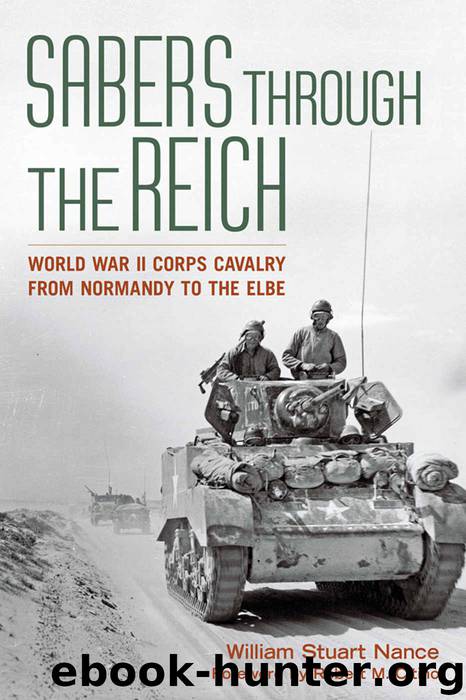Sabers through the Reich: World War II Corps Cavalry from Normandy to the Elbe (Battles and Campaigns) by William Stuart Nance

Author:William Stuart Nance [Nance, William Stuart]
Language: eng
Format: azw3
Publisher: The University Press of Kentucky
Published: 2017-05-01T04:00:00+00:00
Seventh Army
As the crisis in the Ardennes continued to grow, the Third Army required more strength along the southern shoulder of the Bulge. With two of its three corps committed north, the Third Army had to hold most of its original frontage with one corps—Walker’s XX Corps. Eisenhower ordered General Alexander Patch’s Seventh Army to move its boundary with the Third Army twenty-seven miles west to shorten Walker’s line. In order to accomplish this task, Patch called a halt to both of his corps’ attacks. The two corps remained split by the Vosges Mountains, with Haislip’s XV Corps to the west and Truscott’s VI Corps to the east. However, the VI Corps gave the 103rd ID to the XV Corps, as Patch viewed the ground between the Saar River and the Vosges (XV Corps’ sector) as the most dangerous. That division, plus Colonel Wilson’s 106th MCG and elements of the 12th AD, held the new ground gained from the Third Army.85 However, Eisenhower soon called on the Seventh Army for two divisions for a theater reserve. This stripped the army of the 36th ID and 12th AD, leaving it holding a 126-mile front with just five infantry divisions, one armored division, and one and a half cavalry groups. Elements of three newly arrived infantry divisions were en route, and their formations already present in the line were transformed into three ad hoc task forces that would hold large portions of the Seventh Army line, particularly along the Rhine. The 106th MCG anchored the XV Corps’ left, while a fourth task force, comprised of the 117th CRS, the 94th CRS (of the 14th AD), the 62nd Armored Infantry Battalion (also from the 14th AD), and a tank destroyer company occupied the center of the army line in the Vosges Mountains, under the aegis of Task Force Hudelson.86 Thus, the cavalry performed a similar mission to their brethren in the Ninth Army by helping a manpower-strapped army hold a suddenly much larger front.
TF Hudelson took over the old positions of the 106th MCG on 23 December 1944. The 117th CRS settled on the left, linking with the 100th ID around Bitche; the 94th CRS (under the command of the 117th CRS) held the center; and the 62nd Armored Infantry Battalion maintained the right portion of the zone, tying in with the 45th ID at the town of Dambach. Overall, the task force front was about ten miles of extremely broken, forested terrain.87 The next week would be spent reinforcing and improving positions.
At 0100 on the morning of 1 January, elements of four German Volksgrenadier divisions struck TF Hudelson, aiming for the Saverne Gap as part of Operation NORDWIND. This assault had the intention of seizing the gap and linking up with another German assault that struck the center of the XV Corps line farther west in an attempt to encircle part of the XV Corps as well as threaten the rear of the rest of the Seventh Army (see map 14).88
The forward positions of both the 117th and 94th CRS soon found themselves engaged with heavy German forces.
Download
This site does not store any files on its server. We only index and link to content provided by other sites. Please contact the content providers to delete copyright contents if any and email us, we'll remove relevant links or contents immediately.
| Africa | Americas |
| Arctic & Antarctica | Asia |
| Australia & Oceania | Europe |
| Middle East | Russia |
| United States | World |
| Ancient Civilizations | Military |
| Historical Study & Educational Resources |
The Radium Girls by Kate Moore(11642)
100 Deadly Skills by Clint Emerson(4702)
The Templars by Dan Jones(4561)
Rise and Kill First by Ronen Bergman(4554)
The Doomsday Machine by Daniel Ellsberg(4254)
The Rape of Nanking by Iris Chang(4028)
Killing England by Bill O'Reilly(3901)
Hitler in Los Angeles by Steven J. Ross(3804)
Stalin by Stephen Kotkin(3732)
12 Strong by Doug Stanton(3423)
Hitler's Monsters by Eric Kurlander(3174)
Blood and Sand by Alex Von Tunzelmann(3062)
Darkest Hour by Anthony McCarten(3019)
The Code Book by Simon Singh(2877)
The Art of War Visualized by Jessica Hagy(2846)
Hitler's Flying Saucers: A Guide to German Flying Discs of the Second World War by Stevens Henry(2631)
Babylon's Ark by Lawrence Anthony(2438)
The Second World Wars by Victor Davis Hanson(2423)
Tobruk by Peter Fitzsimons(2380)
